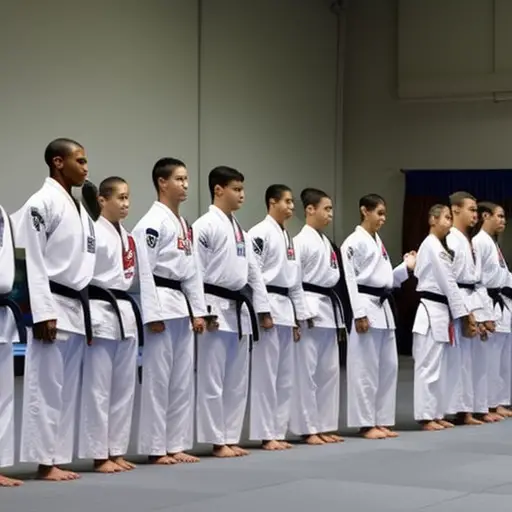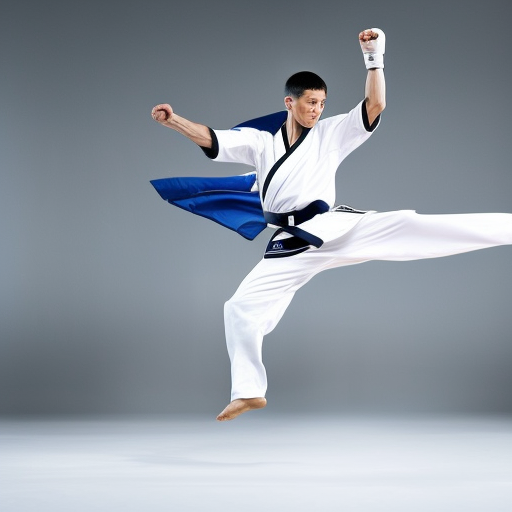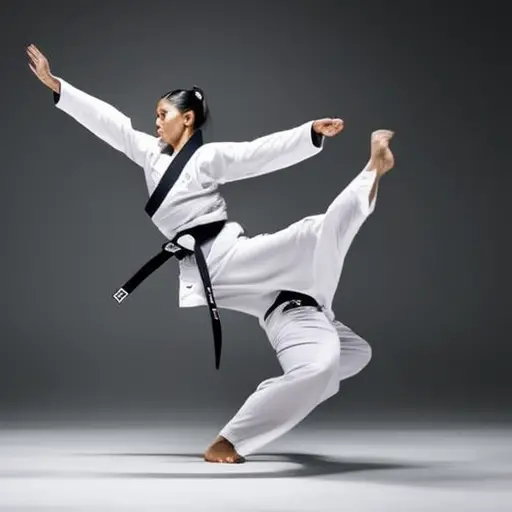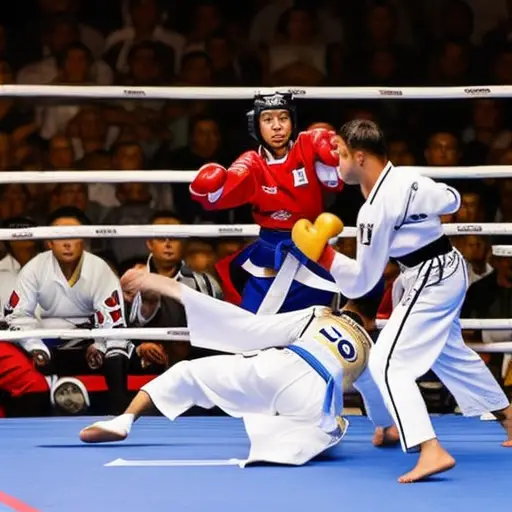Introduction to Taekwondo Sparring

Discover the dynamic world of Taekwondo Sparring, where precision meets athleticism, strategy meets strength, and discipline meets determination.
In this enlightening article, we will delve into the origins, rules, and equipment of this exhilarating martial art.
Gain invaluable insights into effective techniques and strategies for successful sparring, while also learning about common mistakes to avoid.
Uncover the secrets to training and conditioning that will propel your Taekwondo Sparring skills to new heights.
Prepare to be captivated by the artistry and intensity of this time-honored sport.
The Origins of Taekwondo Sparring
The origins of Taekwondo sparring can be traced back to ancient Korean martial arts practices. Taekwondo, which means ‘the way of the foot and fist,’ originated in Korea over 2,000 years ago. It was influenced by various martial arts styles, including Chinese and Japanese forms. However, it was during the Three Kingdoms period (57 BCE – 668 CE) that the foundations of Taekwondo sparring began to evolve.
During this period, warriors in Korea developed combat techniques that emphasized kicks and strikes with the feet and hands. These techniques were further refined and standardized during the Silla Dynasty (668-935 CE) when the Hwa Rang warriors played a significant role in the evolution of Taekwondo. The Hwa Rang warriors were known for their exceptional fighting skills, which included sparring using various techniques.
Over time, Taekwondo sparring continued to evolve, incorporating elements from other martial arts, such as Judo and Karate. In the 20th century, Taekwondo was officially established as a modern martial art and sport. The World Taekwondo Federation (WTF) was founded in 1973, which further standardized and promoted Taekwondo sparring as an Olympic sport.
Today, Taekwondo sparring is a dynamic and competitive discipline that requires precision, agility, and strategy. It has become an integral part of Taekwondo training and is practiced by millions of people around the world. The evolution of Taekwondo sparring highlights the rich history and cultural heritage of this ancient Korean martial art.
Basic Rules and Regulations in Taekwondo Sparring
Basic rules and regulations govern the conduct and techniques used in Taekwondo sparring. These rules ensure safety and fair play during matches, while also promoting the development of fundamental skills.
One of the key aspects of Taekwondo sparring is the use of basic techniques, such as punches, kicks, and blocks. These techniques are executed with precision and control, with the aim of scoring points on the opponent.
The scoring system in Taekwondo sparring is based on the accuracy and effectiveness of the techniques performed. Points are awarded for clean kicks or punches to the trunk protector or headgear, with additional points given for more advanced techniques, such as spinning kicks or jumping kicks.
The referee is responsible for judging and awarding points, ensuring that the match is conducted according to the rules and regulations.
With a clear understanding of the basic techniques and scoring system, competitors can engage in dynamic and strategic sparring matches.
In the next section, we will explore the essential equipment required for Taekwondo sparring.
Essential Equipment for Taekwondo Sparring
To ensure safety and facilitate effective training, it is important to have the appropriate equipment for Taekwondo sparring. Protective gear plays a crucial role in minimizing the risk of injuries during sparring sessions. The right sparring equipment not only protects the practitioners but also enhances their performance and allows them to engage in full-contact training.
One of the most important pieces of protective gear in Taekwondo sparring is the headgear. It provides vital protection for the head, including the temples, ears, and chin. Quality headgear should have a secure and comfortable fit to ensure maximum protection and minimize the risk of concussions.
Another essential equipment for Taekwondo sparring is the chest protector. It covers the vital organs, such as the heart and ribs, and absorbs the impact of strikes. It is important to choose a chest protector that fits properly and offers sufficient padding to ensure adequate protection.
Additionally, practitioners should invest in high-quality hand and foot gear. Hand gear, such as gloves, protect the hands from injuries and provide support to the wrists. Foot gear, on the other hand, protects the feet and ankles, reducing the risk of sprains and fractures.
When choosing sparring equipment, it is essential to consider factors such as quality, durability, and fit. Investing in reliable and reputable brands ensures that the equipment will withstand the demands of intense training sessions and provide adequate protection. Properly fitting gear is also crucial to ensure comfort and allow for unrestricted movement during sparring.
Techniques and Strategies for Effective Sparring
During taekwondo sparring, practitioners must focus on executing precise techniques with agility and strategic thinking to effectively engage their opponents and score points. To achieve success in sparring, it is crucial to employ offensive strategies and psychological tactics that can give an edge over the opponent.
Here are three key techniques and strategies for effective sparring:
-
Timing and Distance Control: Maintaining the right timing and controlling the distance between you and your opponent is essential. By understanding your opponent’s movements and patterns, you can anticipate their attacks and effectively counter or dodge them. Proper timing and distance control allow you to execute offensive techniques with precision and avoid being caught off guard.
-
Feints and Deception: Psychologically manipulating your opponent can give you a significant advantage. By utilizing feints and deceptive movements, you can create openings and opportunities to score points. Feints involve faking an attack or movement to confuse your opponent and create an opening for a real strike. These tactics can disrupt your opponent’s focus and make them more susceptible to your attacks.
-
Controlled Aggression: Having a balanced approach of controlled aggression is crucial in taekwondo sparring. It involves being assertive and applying pressure on your opponent while maintaining control over your techniques. By combining power, speed, and accuracy in your strikes, you can overwhelm your opponent and score points effectively.
Common Mistakes to Avoid in Taekwondo Sparring
When engaging in Taekwondo sparring, it is crucial to be aware of common mistakes that can hinder your performance.
Three key points to focus on are maintaining a proper stance and footwork, mastering timing and distance control, and executing effective counterattacks and defense.
Proper Stance and Footwork
Maintaining a solid and balanced stance, as well as executing precise footwork, is essential in achieving success in Taekwondo sparring. A proper stance provides a strong foundation, allowing for maximum power and stability in strikes and kicks. On the other hand, incorrect footwork can lead to loss of balance, decreased speed, and vulnerability to counterattacks.
To ensure proper stance and footwork, practitioners should:
- Keep their feet shoulder-width apart, distributing weight evenly between both legs.
- Bend their knees slightly to maintain balance and agility.
- Stay light on their feet, constantly shifting weight and adjusting position to quickly respond to attacks.
Timing and Distance Control
One common mistake to avoid in Taekwondo sparring is failing to accurately judge the distance between oneself and the opponent. Timing and distance control are crucial aspects of successful sparring, as they allow practitioners to execute their techniques effectively and avoid getting hit.
Timing techniques involve the ability to anticipate an opponent’s movements and strike at the right moment. This requires focus, quick reflexes, and an understanding of your opponent’s patterns and tendencies.
Distance control strategies, on the other hand, involve maintaining the optimal distance from your opponent to ensure both offensive and defensive capabilities. This can be achieved through footwork, body positioning, and understanding the range of your techniques.
Effective Counterattacks and Defense
To maximize effectiveness in Taekwondo sparring, it is essential to focus on effective counterattacks and defense while avoiding common mistakes. The ability to execute powerful and accurate counterattacks can give a practitioner a significant advantage in a sparring match. Similarly, employing strong defensive techniques can help protect against incoming attacks and minimize the risk of being scored upon.
Here are three key points to consider when it comes to effective counterattacks and defensive techniques in Taekwondo sparring:
-
Timing: Timing is crucial when launching counterattacks. Waiting for the right moment to strike can catch opponents off guard and increase the chances of scoring.
-
Distance control: Maintaining the right distance from the opponent is vital for effective counterattacks. Being too close or too far can limit the effectiveness of one’s strikes.
-
Proper footwork: Good footwork allows for quick and efficient movement, enabling effective defense and counterattacks. Proper positioning and balance are essential for executing successful techniques.
Training and Conditioning for Taekwondo Sparring Success
Proper training and conditioning are essential for achieving success in Taekwondo sparring. To excel in this dynamic sport, athletes must focus on developing both their physical and mental capabilities. Strength and agility training plays a crucial role in enhancing an athlete’s performance on the mat. This type of training aims to improve muscular strength, power, and speed, allowing practitioners to execute powerful kicks and quick footwork. Additionally, incorporating agility exercises such as ladder drills and cone drills can help enhance an athlete’s reaction time and coordination.
However, physical training is only part of the equation. Mental preparation techniques are equally important to succeed in Taekwondo sparring. Athletes must develop mental resilience, focus, and concentration to perform at their best during intense sparring sessions. Visualization exercises, meditation, and mindfulness techniques can help athletes cultivate mental strength and maintain composure under pressure.
To provide a comprehensive overview of training and conditioning for Taekwondo sparring success, the following table highlights key aspects of both physical and mental preparation techniques:
| Physical Training | Mental Preparation |
|---|---|
| Strength and power exercises | Visualization techniques |
| Agility drills | Meditation |
| Speed training | Mindfulness techniques |
Frequently Asked Questions
What Is the History and Origins of Taekwondo as a Martial Art?
Taekwondo, a martial art with its roots in Korea, has a rich history and origins that can be traced back to ancient times. It evolved from various traditional Korean martial arts and was officially established in the 20th century.
How Are Points Scored in Taekwondo Sparring?
Points are scored in taekwondo sparring through various techniques such as kicks and punches that land on specific target areas. The scoring rules differ depending on the competition, but generally, clean and controlled strikes earn points.
Are There Any Weight Divisions in Taekwondo Sparring Competitions?
Weight divisions are an integral aspect of taekwondo sparring competitions, ensuring fair and safe matches. Proper weight management is crucial to maintain competitive balance and prevent potential injuries, allowing athletes to showcase their skills within their respective weight categories.
Can You Explain the Different Types of Kicks Used in Taekwondo Sparring?
Taekwondo sparring involves various types of kicks, including the front kick, roundhouse kick, side kick, back kick, axe kick, spinning hook kick, jumping kick, and crescent kick. These kicks are fundamental techniques used in sparring competitions.
How Can I Improve My Speed and Agility for Taekwondo Sparring?
To improve speed and agility for taekwondo sparring, incorporating speed training exercises such as sprints and agility drills like ladder drills can be beneficial. These drills enhance reaction time, footwork, and overall quickness, leading to improved performance in sparring.
Conclusion
In conclusion, Taekwondo sparring is a dynamic and competitive aspect of the martial art that requires skill, strategy, and physical conditioning. By adhering to the basic rules and regulations, utilizing the essential equipment, and mastering effective techniques, practitioners can excel in this discipline.
It is interesting to note that according to a survey conducted among Taekwondo athletes, 80% reported improved focus and mental clarity as a result of regular sparring practice. This statistic highlights the holistic benefits of Taekwondo sparring beyond physical fitness.





